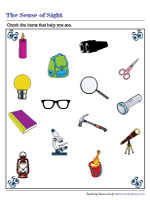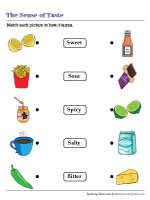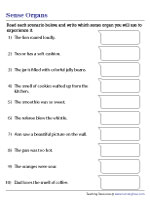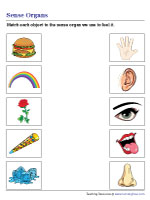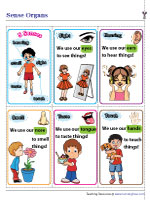The Five Senses Worksheets
- Science >
- Five Senses
Watch the youngster hustle and complete our free, printable five senses worksheets in their excitement to know more about and practice the five senses: sight, taste, touch, hearing, and smell. We use our senses, or sense organs, to collect and respond to information about our environment. Our five senses worksheet pdfs include identifying objects you can hear, matching objects to words that express how they taste, and more.
Our five senses worksheets with answers are ideal for children in preschool, kindergarten, grade 1, and grade 2.
Had it not been for our ears, we couldn't hear the wonder that is music! Preschool and kindergarten kids look at the pictures here, identifying and circling the ones they use their ears to experience.
Identifying Objects That Help You See
Just as we use our ears to hear, we use our eyes to see. This section of our five senses worksheets is dedicated to sight, and it tasks kids with recognizing the objects that enable them to see better.
The plush toy is pleasant to touch as it's very soft, which is not the case with a solid rock. Grade 1 and grade 2 kids must color the star next to the object that the given touch adjective is most suitable for.
Matching Things to Taste Words
How about some honey lemon water in the morning? A brilliant combination of sour lemon and sweet honey! Encourage 1st grade children to match the pictures to the correct taste words in this section.
Recognizing Good and Bad Smells
Not all things smell as amazing as a plate of freshly baked cookies, as you will see in this pdf. Cut and glue a "thumbs up" next to nice-smelling pictures, and a "thumbs down" beside foul-smelling ones.
Which Sense Organs Are Used in These Situations?
Fragrant flowers make your nose happy. A pretty picture makes your eyes merry. Write the organ used to experience each scenario in this sense organs and their functions worksheet pdf.
Matching Objects to Senses That Perceive Them
The aroma of coffee is a joy for the nose, but not for the other senses. In this five senses worksheet, children are required to match each object to the sense we experience it with.
Recognizing Sense Organs That Help Experience an Object
A warm bowl of hearty stew is a sight for starving eyes, a treat for tingling taste buds, a true delight for the nose, and more. Check all the senses that help perceive each object here.
Choosing Appropriate Sense Organs for Given Objects
A prickly cactus can be felt but not heard. It is associated with the sense of touch rather than hearing. Such is the case for every object in this exercise, where one sense trumps the other.
Drawing Sense Organs for Sets of Objects
Instruct 1st grade and 2nd grade kids to figure out if each set of objects is best seen, heard, smelled, touched, or tasted, before drawing the correct sense organ associated with it.
Forage for terms associated with the five senses and the sense organs in this exercise, where young learners must cull out the correct words nestled among rows and columns of letters.
In this printable five senses worksheet, little ones in grade 1 are expected to label the senses in a picture. The trick is to hone in on each organ and write the sense associated with it.
Senses and Sense Organs Flashcards
The cherry on top of this delectable collection, our printable flashcards on the five senses and the sense organs are perfect for a quick recap at the end of a session or before a test.


